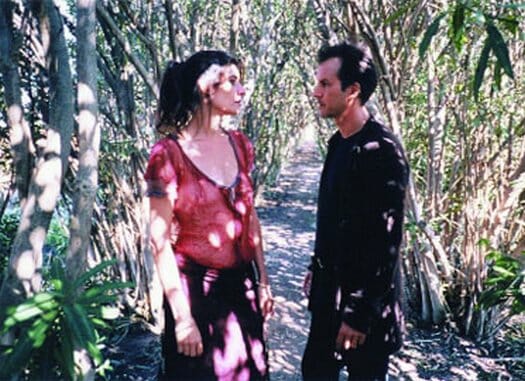The first film is Wong’s. It’s drawn from the same universe glimpsed in The Days of Being Wild and exquisitely realized in 2000’s In the Mood for Love. Entitled “The Hand,” it’s a visually moody piece about a woman who dallies with her shy tailor, complete with the perfectly timed tracking shots we’ve come to expect from Wong and his cinematographer Christopher Doyle. Once again they have the magic touch, but unfortunately so does the woman in the story. She lends her glove to the film’s title, and the film focuses too tightly on visceral, trite experience to be erotic.
Soderbergh provides the comic relief, but his film, “Equilibrium,” is the least interesting of the three. A dialog between bored psychiatrist Alan Arkin and his patient, Robert Downey, Jr., it’s more like an extended sketch than a movie, with a few genuine laughs and a neat framing device, but not quite enough energy to sustain its length.
The final film—the one that sends people jabbering into the lobby when the lights come up—is “The Dangerous Thread of Things” by 92-year-old Antonioni, the only legend of the three and the only one to turn in a complete head-scratcher. It involves a naked romp on the beach, a stilted argument between lovers, random, irrelevant locations and awkward silences. The chatter in the lobby, I predict, will be from people wondering how and when the old man flipped his lid.
I’d be among them if I hadn’t seen Antonioni’s other recent short, last year’s magnificent Michaelangelo Eye to Eye, which is more beautiful and thought-provoking at 17 minutes than anything in Eros. Antonioni has been confined to a wheelchair since his stroke in 1985, but in this film, thanks to the magic of cinema, he walks into a church to gaze up at a sculpture of Moses by that other Michaelangelo. As he looks up at the stone and shifts on his loafers, the camera glides along the sculpture’s surface, its brow furrowed deep by the angle of the light, its firm, rigid feet standing before Antonioni’s frail frame. Then without a word Antonioni leaves the church, but only after we’ve had a few quiet moments to think of his, and our, frailty, to think of the stones in his early film L’Avventura that swallowed a woman whole, and to think of age and mortality and the joy of walking, touching and seeing with clarity.
Eros won’t leave you with any of that, and certainly Antonioni bears at least a third of the blame. The film is a failure, no matter how grandiose its title or the names above it, not because the three parts don’t connect, but because each of them could be better. Still, I’m hesitant to discount the project as a whole. There are far too few opportunities—besides the tiny screen in your living room, the one that interrupts the film periodically to sell sugar water—for filmmakers to try something outside the usual length and scope.
